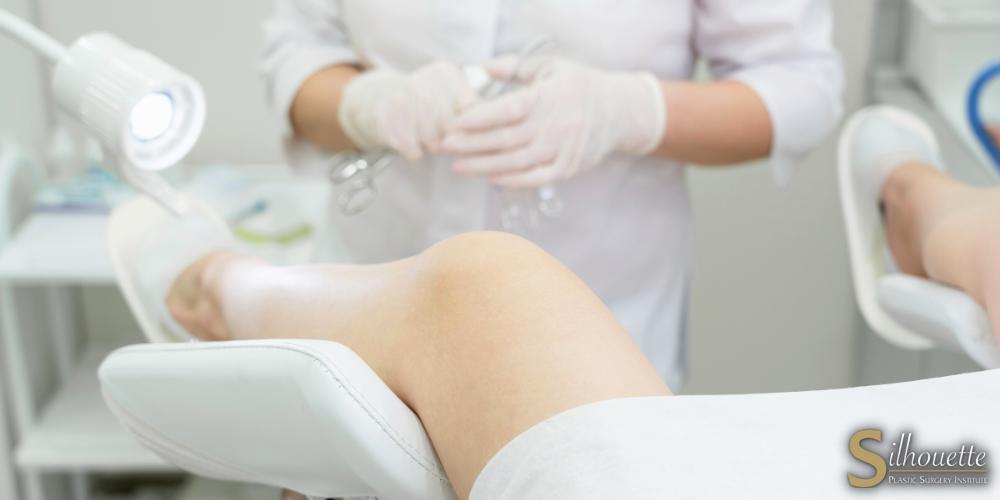Dr. Hootan Daneshmand
Vaginal Rejuvenation
Home » Our Procedures » Body Surgery Procedures » Vaginal Rejuvenation
Vaginal Rejuvenation in Bakersfield and Orange Co
Many women notice drastic changes in both the appearance and function of their vaginas after major hormonal changes such as pregnancy, childbirth, and menopause. Aging, in general, also leads to changes in aesthetics and function. If these changes have started to affect your self-esteem, sexual relationship, and overall health, you may be a good candidate for vaginal rejuvenation procedures. Vaginal rejuvenation can be done purely for cosmetic reasons, but many procedures provide functional and medical benefits as well. Below, Dr. Daneshmand breaks down everything you need to know about vaginal rejuvenation procedures.
Call 949-359-8397 to schedule an appointment at Silhouette Plastic Surgery Institute today.

What is Vaginal Rejuvenation?
Vaginal rejuvenation is characterized by any type of procedure, surgical or non-surgical, that’s designed to make the vagina look or function better. Female genitals change drastically over the course of a lifetime, mostly due to major hormonal changes during puberty, pregnancy, childbirth, and menopause. Major hormonal fluctuations like this can lead to a variety of medical, functional, and cosmetic issues, all of which vaginal rejuvenation procedures can fix.
Common Reasons Why People Undergo Vaginal Rejuvenation Procedures
Listed below are the most common reasons why people may choose to undergo female genital cosmetic surgery:
- Excessive tissue around the labia majora and/or labia minora
- Stress urinary incontinence (AKA urinary leakage) during physical activity such as jumping, running, laughing, sneezing, coughing, etc.
- Vaginal dryness
- Vaginal tightness or looseness
- Painful intercourse and/or sexual dysfunction
- Loss of sexual satisfaction and/or sensation
- Low self-esteem about how the vaginal looks
- General vaginal discomfort while wearing certain clothing (such as leggings) or doing certain activities (such as exercise)
- Repairing damage or cosmetic concerns from childbirth injuries
- Gender-affirming care
Some of these issues, such as urinary incontinence and vaginal dryness, can be improved through a combination of physical therapy for the pelvic floor, medication, and/or hormonal replacement therapy. However, if issues persist even with these treatments, a doctor may recommend more invasive options, such as female genital cosmetic surgery.

Common Types of Vaginal Rejuvenation Procedures
There are many types of vaginal rejuvenation treatments out there, both surgical and non surgical, that target different cosmetic, medical, and functional issues. Listed below are the most popular surgical and nonsurgical vaginal rejuvenation procedures, and what they’re designed to do.
Surgical Procedures
Surgical vaginal rejuvenation procedures include:
- Labiaplasty is a surgical procedure that changes the shape and size of the vaginal lips, also known as the labia minora and labia majora.
- Clitoral Hood Reduction is a surgical procedure that removes the skin that surrounds the clitoris.
- Vaginoplasty: During this procedure, a surgeon will tighten and/or repair the vaginal canal. This procedure is most commonly performed after childbirth.
- Monsplasty: During this procedure, a surgeon will remove excessive tissue from the mons pubis (the pubic bone area), usually through liposuction.
- Perineoplasty: This surgical treatment is characterized by the tightening of the area between the vagina and anus, called the perineum.
- Vulvoplasty: This surgical treatment changes the shape and size of the external female genitalia, called the vulva. Those who are designated male at birth (DMAB) may also undergo a vulvoplasty (in order to create a vulva) as part of their gender affirming care.
Non Surgical Procedures
Nonsurgical vaginal rejuvenation procedures are usually less expensive, less painful, and far less invasive than the aforementioned surgeries. The two main nonsurgical procedures include:
- CO2 Laser Treatment is most commonly used for cosmetic concerns such as facial wrinkles, sun spots, acne scars, and birthmarks. However, CO2 laser treatment can be used for vaginal rejuvenation purposes as well. The laser heats up and damages the upper layers of skin in order to stimulate collagen production. Collagen is a protein that makes our skin look youthful, firm, and smooth. So CO2 laser treatment around the vaginal area can improve overall appearance by smoothing and tightening the skin. Laser treatment can also be an effective treatment for women with vaginal atrophy. Ask your doctor about these treatment brand names – FemiLift®, MonaLisa Touch®, and FemTouch®.
- Radio Frequency (RF) Treatment works the same way as CO2 laser vaginal rejuvenation in that it heats and damages the vaginal skin to encourage collagen production. The main difference is that the skin is heated through electromagnetic waves, not lasers. Ask your doctor about these treatment brand names – ThermiVA®, Emsella®, and Viveve®.
How Surgical Vaginal Rejuvenation Works
The exact surgical method depends on the procedure you choose. Generally, though, this is what you can expect when you go through a female genital cosmetic surgery.
First, you’ll have to meet with your surgeon to discuss your symptoms, cosmetic concerns, and which surgical procedure would be best for you. You should use this appointment to learn about your plastic surgeon and their experience as well as ask any questions you may have about your body and/or surgical procedure.
Most surgical vaginal rejuvenation procedures last between 2 to 4 hours, again, depending on the type of surgery you choose. You’ll be sedated with general anesthesia, and then your plastic surgeon will begin making incisions in the vaginal skin and muscles. Your surgeon may use these incisions to change the size and shape of your vulva, labia minora/majora, vaginal opening, perineum, mons pubis, and/or clitoral hood, depending on what you asked for. Then your surgeon will close the incisions with dissolvable stitches and send you out to your recovery room.
Once you’re awake and recovering, your surgeon will send you home with a list of aftercare instructions that may include medications, pain relief, vaginal hygiene, and activities to avoid (such as sexual intercourse). The healing process could take anywhere from 4 to 8 weeks.
How Non Surgical Vaginal Rejuvenation Works
Radiofrequency and laser vaginal rejuvenation procedures are much quicker and less invasive compared to the aforementioned surgeries.
You’ll start the process the same way as you would start the surgical process: with a consultation with your plastic surgeon. Here, you’ll discuss symptoms, cosmetic concerns, and which non-surgical procedure would be best for you. Be sure to ask lots of questions and become familiar with your surgeon.
Both laser and RF vaginal rejuvenation procedures can last anywhere from 10 to 30 minutes. These procedures are relatively painless, so you may not need any form of anesthesia. If you’re nervous about feeling any pain or discomfort, you could ask for a topical anesthetic. Your surgeon will then insert a wand or probe into the vagina (or move it across the outside of the vagina) to heat up the skin and stimulate collagen production.
After the procedure, it’s common for patients to feel warm or tingly in the treatment area. Your doctor will send you home with specific aftercare instructions, which you should carefully follow to have the best cosmetic results. The healing process could take anywhere from a few days to 2 weeks.

Benefits of Vaginal Rejuvenation
Vaginal rejuvenation procedures come with many benefits, including:
- Improved vaginal appearance,
- Improved stress urinary incontinence,
- Stronger pelvic and vaginal muscles,
- Increased vaginal lubrication,
- Heightened vaginal sensitivity,
- Improved sexual pleasure,
- And less pain during sex.
Risks and Side Effects of Vaginal Rejuvenation
Just like all surgeries and non-invasive treatments, vaginal rejuvenation procedures have their own sets of risks. Some vaginal rejuvenation procedures are not as safe or effective as others. In fact, the FDA has warned patients that some vaginal rejuvenation treatments have incredibly deceptive marketing tactics. So be sure to discuss all potential risks with your doctor before going under the knife (or laser).
Some of the risks and side effects include:
- Pain, swelling, redness, and/or scarring after the procedure.
- Excessive bleeding.
- Infection.
- Painful sex.
- Loss of vaginal sensitivity.
- Cosmetic results that you don’t like.
- An ineffective procedure.
Sex After Vaginal Rejuvenation
The most common question that vaginal rejuvenation patients ask is – when is it safe to have sex again? The answer depends on what type of procedure you underwent. Because of the non-invasive nature of RF and laser treatments, patients can usually resume sexual intercourse between 3 and 5 days after their procedure. Of course, if you notice any bleeding, infection, or increased swelling or pain, refrain from sex and call your doctor.
Patients who underwent cosmetic surgery in the vaginal area should wait several weeks before having sex. Your doctor will give you specific instructions on how long to refrain from sexual intercourse depending on the type of surgery you had.
Are Vaginal Rejuvenation Results Permanent?
Generally, no, vaginal rejuvenation procedures are not permanent. RF and laser patients may require multiple treatments to obtain and maintain the results they want. Surgical patients, on the other hand, may have what we call semi-permanent results. The results will stick around for several years, but as the body continues to age and go through hormonal changes, the results will change or maybe even revert back to the original state. Your plastic surgeon will be able to give you a good idea of exactly how long your results will last.
Vaginal Rejuvenation Cost
The cost of vaginal rejuvenation will depend on many factors, including what procedure you choose, how many procedures you need (for RF and laser specifically), your geographic location, and your plastic surgeon’s experience level.
Here are the average costs according to a site called RealSelf, where doctors and patients discuss all things plastic surgery:
- Labiaplasty: $4,375
- Clitoral Hood Reduction: $5,121
- Vaginoplasty: $6,551
- Monsplasty: $6,044
- Perineoplasty: $5,398
- CO2 Laser Treatment: $2,500
- Radiofrequency (RF) Treatment: $2,364
Be sure to schedule an appointment at Silhouette Plastic Surgery Institute to get an exact price tag.
It’s important to note that, as a rule of thumb, health insurance will not cover the cost of any cosmetic surgery, because it’s considered “elective” and not medically necessary. However, some vaginal rejuvenation procedures are medically necessary for conditions such as vaginal atrophy, urinary incontinence, and childbirth injuries. So if you’re undergoing one of these procedures to fix a medical or functional problem, your insurance should provide partial or complete coverage.

